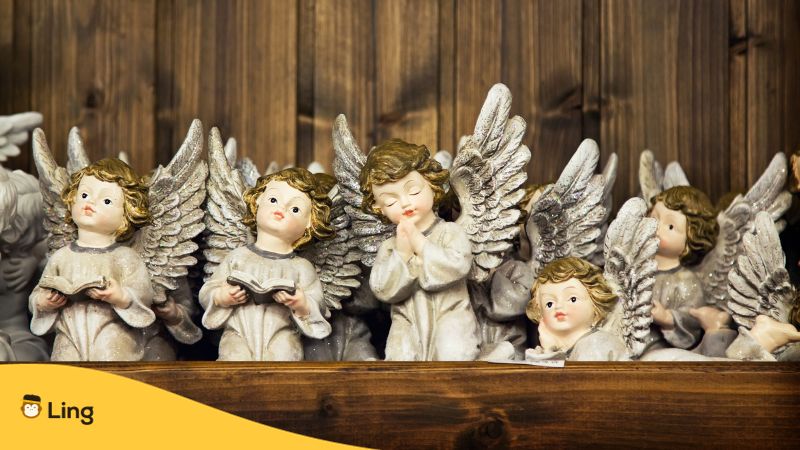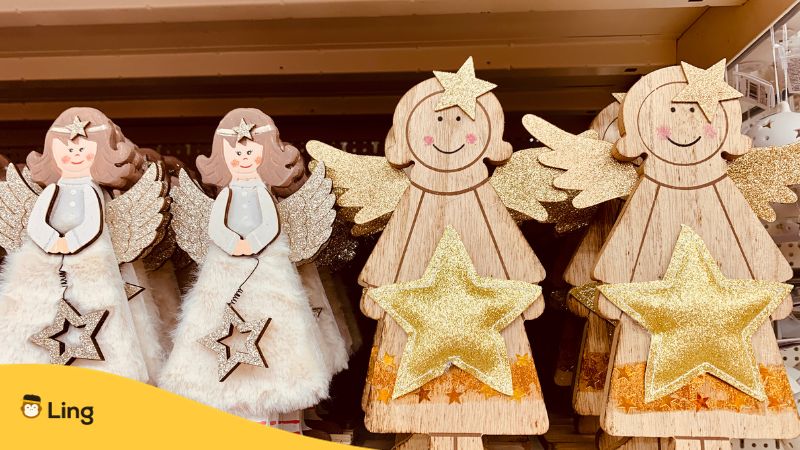Have you ever found yourself staring at the sky and wondering if those fluffy clouds are concealing heavenly creatures? Well, I’m not suggesting that winged beings exist above us, but it’s an interesting notion to think about, isn’t it? This article expounds more on anghel (pronounced as ang-hel) or angel in Tagalog. You know those divine messengers we read in stories, see in art, and sometimes use them in our everyday language! You ready? Let’s start!
Did you know that the Philippines is one huge Catholic fan club? Yes, we are majorly Catholic, and angels are a big deal here. It isn’t just about those little baby cherub figurines or kerubin in Tagalog that grandmas love to collect. It goes beyond that. For example, if you did something good older people might say to you, “Ay, parang anghel!”(Oh, like an angel!). Filipinos can also throw out the phrase “Mala-anghel sa ganda” (angelic beauty) if a woman looks super good.
And the real kicker here, Angel is also one of the top girl names in the Philippines as of 2021, according to data from the Philippine Statistics Authority. That’s right – walk down any street, and you might bump into an Angel or two. If you ask locals, they will tell you that naming a child ‘Angel’ is like infusing goodness and hope right at birth. Don’t trust me? Simply look for how many Angels (or variations like Anghelita, Angelina, and Angelica) are there in showbiz in the Philippines!
Want to learn more? Read on below!

What Is Angel In Tagalog?
If you’re diving into the beautiful world of Tagalog, here’s a word you’ll love to learn: ‘Angel.’ Now, roll out the red carpet for its Tagalog counterpart – ‘Anghel.’ Pronounced “ang-hel,” it’s as melodious as it sounds.
But how do you sprinkle this word into your conversations like a pro? Let’s break it down with some simple yet charming examples:
- Basic Translation:
- English: “The child believes in angels.”
- Tagalog: “Naniniwala ang bata sa mga anghel.”
- Describing Someone Kind:
- English: “She is like an angel.”
- Tagalog: “Para siyang anghel.”
- Angel Names:
- English: “Angel is a common name here.”
- Tagalog: “Karaniwan dito ang pangalan na Angel.”
- Using in a Metaphor:
- English: “He has the patience of an angel.”
- Tagalog: “May pasensya siya ng isang anghel.”
- In Expressions of Endearment:
- English: “My little angel, sleep well.”
- Tagalog: “Ang aking munting anghel, matulog kang mahimbing.”

Angel-Related Words In Tagalog
Tagalog’s got more up its sleeve when it comes to angel talk. Let’s dive into some cool angel-related words that add a bit of heaven to our chats.
Arkanghel (Archangel)
“Arkanghel” means “archangel,” those top-tier angels.
- “Michael is an archangel.”
- “Si Michael ay isang arkanghel.”
Kerubin (Cherub)
“Kerubin” are those adorable young angels in art.
- “Cherubs are depicted as young angels.”
- “Ang mga kerubin ay inilalarawan bilang mga batang anghel.”
Serapin (Seraph)
“Serapin” are seraphs, known for their six flashy wings.
- “Seraphs are known for their six wings.”
- “Kilala ang mga serapin sa kanilang anim na pakpak.”
Anghel De La Guarda (Guardian Angel)
A mix of Spanish and Tagalog, “Anghel de la Guarda” means guardian angel.
- “Many believe in the protection of guardian angels.”
- “Marami ang naniniwala sa proteksyon ng mga anghel de la guarda.”
Anghel Sa Lupa (Angel On Earth)
It’s a sweet way to call someone super kind.
- “Nurses are like angels on earth during these times.”
- “Ang mga nars ay parang mga anghel sa lupa sa panahong ito.”
Cultural Significance Of Angels In The Philippines
Did you hear about the Philippines’ love affair with Catholic icons? Pop into any Filipino home, and you’ll spot a bunch. One of the most collected items? Cherubs! Yep, those cute, chubby-cheeked little guys you see chilling on shelves and mantels. A lot of Filipinos think these cherubs are like good vibe magnets, keeping the bad juju out and blessing the house. Come Christmas or Easter, these little cherubs aren’t just sitting pretty – they’re symbols of joy and innocence.
Apart from cherubs, there are also figurines of angels and some saints that are quite popular. Some of them are designed to be small and simple, while others are made by artisans in a complex manner. To collect these figures is not just a hobby, it is keeping one’s faith and values alive all through the day. In some houses, there might be whole cabinets filled with these spiritual protectors.
Frequently, these are angelic and saintly statues cherished from one generation to another as part of family inheritance. Similarly, they are popularly given during weddings, baptisms, or birthdays to symbolize good luck and blessings.
This tradition of collecting figurines is deeply rooted in the Philippines’ Catholic heritage. It reflects the Filipino people’s enduring faith and the comfort they find in these symbolic guardians. For many, each figurine tells a story, be it of personal faith, family history, or cultural heritage.
Learn Tagalog With Ling
In this exploration of ‘angels’ in Filipino culture, we have seen that these celestial beings are not merely religious symbols. They are something you can come across within the everyday life, language, and customs of the Philippines. From the Tagalog word ‘anghel’ to angelic figurines that are loved by many Filipinos in their homes, one can easily see how much heaven figures portray the rich spiritual and cultural heritage of the country.
Wanna learn more? If you want to explore Filipino culture and the Tagalog language, there is a resource that can be helpful. You can get the Ling app from the App Store or Play Store. Here, you will find Tagalog as well as diverse cultural aspects of the Philippines in a comprehensive approach. Give it a shot!































































